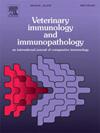In silico design of multi-epitope vaccine candidate based on structural proteins of porcine reproductive and respiratory syndrome virus
IF 1.4
3区 农林科学
Q4 IMMUNOLOGY
引用次数: 0
Abstract
Porcine reproductive and respiratory syndrome virus (PRRSV) is one of the most common respiratory disease-causing viral agents. Swine infected with PRRSV exhibit severe respiratory symptoms and reproductive failure, leading to significant economic losses. To address this issue, inactivated and live-attenuated vaccines have been developed. However, the current commercially available PRRSV vaccines do not confer sufficient protection or have safety issues. The use of epitope-based subunit vaccines reduce safety risks by including only specific immunogenic portions of the antigens. To enhance immune protection, this study targeted multiple structural proteins of PRRSV, including GP2, GP3, GP4, GP5, membrane (M), envelope (E), GP5a, and nucleocapsid (N), to enable the discovery of novel epitopes. Thus, a reverse vaccinology approach was utilized to design a multi-epitope subunit vaccine construct against PRRSV. Using different tools, seven linear B cell, seven cytotoxic T cell, and three helper T cell epitopes were predicted to be safe, antigenic, and immunogenic. These epitopes were linked together, and a protein adjuvant, heparin-binding hemagglutinin, was added to increase the vaccine's immunogenicity. The construct was then docked to Toll-like receptor 4 (TLR4) to assess its ability to initiate the innate immune response. The final vaccine construct was determined to be antigenic, stable, non-allergenic, and soluble. Furthermore, the vaccine demonstrated stable binding to TLR4 based on coarse-grained and atomistic molecular dynamics simulations. Finally, the immune simulation of the vaccine construct showed a robust immune response against PRRSV. In this study, a candidate vaccine construct was successfully designed as a potential strategy against PRRSV.
基于猪繁殖与呼吸综合征病毒结构蛋白的多表位候选疫苗的计算机设计。
猪繁殖与呼吸综合征病毒(PRRSV)是最常见的呼吸道疾病病原之一。感染PRRSV的猪表现出严重的呼吸道症状和生殖衰竭,导致重大的经济损失。为解决这一问题,已开发出灭活疫苗和减毒活疫苗。然而,目前市售的PRRSV疫苗不能提供足够的保护或存在安全问题。基于表位的亚单位疫苗的使用通过仅包括抗原的特异性免疫原性部分来降低安全风险。为了增强免疫保护,本研究针对PRRSV的多种结构蛋白,包括GP2、GP3、GP4、GP5、膜(M)、包膜(E)、GP5a和核衣壳(N),发现新的表位。因此,利用反向疫苗学方法设计了一种针对PRRSV的多表位亚单位疫苗结构。使用不同的工具,7个线性B细胞、7个细胞毒性T细胞和3个辅助T细胞表位被预测为安全、抗原和免疫原性。这些表位连接在一起,并添加一种蛋白佐剂,肝素结合血凝素,以增加疫苗的免疫原性。然后将构建物与toll样受体4 (TLR4)对接,以评估其启动先天免疫反应的能力。最终的疫苗结构被确定为具有抗原性、稳定性、非过敏性和可溶性。此外,基于粗粒度和原子分子动力学模拟,该疫苗显示出与TLR4的稳定结合。最后,疫苗结构的免疫模拟显示对PRRSV具有强大的免疫应答。在本研究中,成功设计了一种候选疫苗结构,作为对抗PRRSV的潜在策略。
本文章由计算机程序翻译,如有差异,请以英文原文为准。
求助全文
约1分钟内获得全文
求助全文
来源期刊
CiteScore
3.40
自引率
5.60%
发文量
79
审稿时长
70 days
期刊介绍:
The journal reports basic, comparative and clinical immunology as they pertain to the animal species designated here: livestock, poultry, and fish species that are major food animals and companion animals such as cats, dogs, horses and camels, and wildlife species that act as reservoirs for food, companion or human infectious diseases, or as models for human disease.
Rodent models of infectious diseases that are of importance in the animal species indicated above,when the disease requires a level of containment that is not readily available for larger animal experimentation (ABSL3), will be considered. Papers on rabbits, lizards, guinea pigs, badgers, armadillos, elephants, antelope, and buffalo will be reviewed if the research advances our fundamental understanding of immunology, or if they act as a reservoir of infectious disease for the primary animal species designated above, or for humans. Manuscripts employing other species will be reviewed if justified as fitting into the categories above.
The following topics are appropriate: biology of cells and mechanisms of the immune system, immunochemistry, immunodeficiencies, immunodiagnosis, immunogenetics, immunopathology, immunology of infectious disease and tumors, immunoprophylaxis including vaccine development and delivery, immunological aspects of pregnancy including passive immunity, autoimmuity, neuroimmunology, and transplanatation immunology. Manuscripts that describe new genes and development of tools such as monoclonal antibodies are also of interest when part of a larger biological study. Studies employing extracts or constituents (plant extracts, feed additives or microbiome) must be sufficiently defined to be reproduced in other laboratories and also provide evidence for possible mechanisms and not simply show an effect on the immune system.

 求助内容:
求助内容: 应助结果提醒方式:
应助结果提醒方式:


